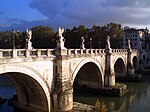Alcántara Bridge
Alcántara Bridge | |
|---|---|
 | |
| Coordinates | 39°43′21″N 6°53′33″W / 39.72242°N 6.892444°W |
| Crosses | Tagus River |
| Locale | Alcántara, Spain |
| Heritage status | Listed as cultural heritage since 1921[1] |
| Characteristics | |
| Design | Roman arch bridge |
| Material | Stone |
| Total length | 194 metres (636 ft)[2] |
| Width | 8 metres (26 ft)[2] |
| Height | 71 metres (233 ft)[2] |
| Longest span | 28.8 metres (94 ft)[2] |
| No. of spans | 6 |
| Load limit | 52 t[3] |
| History | |
| Designer | Caius Julius Lacer |
| Construction start | 104 CE |
| Construction end | 106 CE |
| Location | |
 | |
The Alcántara Bridge (also known as Puente Trajan at Alcantara) is a Roman stone arch bridge built over the Tagus River at Alcántara, Spain between 104 and 106 CE by an order of the Roman Emperor Trajan in 98.[4] It bears the inscription Pontem perpetui mansurum in saecula (I have built a bridge which will last forever) on the archway over the central pier.[4]
History
The Alcántara Bridge has taken more damage from war than from the elements. The Moors destroyed the smallest arch on the left side in 1214. This was rebuilt in 1543 with stone from the original quarries. The second arch on the right side was destroyed by the Spanish to stop the Portuguese and was repaired in 1762 by Charles III, only to be blown up again in 1809 to stop the French. Temporary repairs made in 1819 were replaced in 1860 with mortared masonry.[4]
See also
References
- ^ Patrimonio histórico: Bienes culturales protegidos. Consulta de bienes inmuebles. Bien: "Puente de Alcántara", retrieved 13-01-2010 Template:Es
- ^ a b c d Alcantara Bridge at Structurae
- ^ Manuel Durán Fuentes: "Estudio sobre las bóvedas de los puentes romanos", Nuevos Elementos de la Ingeniería Romana, III Congreso de las Obras Públicas Romanas, Astorga 2006, p. 136
- ^ a b c Whitney, Charles S. (2003) [1929], Bridges of the World: Their Design and Construction, Mineola, New York: Dover Publications, pp. 75–79, ISBN 0-486-42995-4
Further reading
- Brown, David J. (1993), Bridges, New York: Macmillan Publishing Company, p. 25, ISBN 002517455X
- Galliazzo, Vittorio (1994), I ponti romani. Catalogo generale, vol. Vol. 2, Treviso: Edizioni Canova, pp. 353–358 (No. 754), ISBN 88-85066-66-6
{{citation}}:|volume=has extra text (help) - Graf, Bernhard (2002), Bridges that Changed the World, Munich: Prestel, pp. 20–21, ISBN 3791327011
- O’Connor, Colin (1993), Roman Bridges, Cambridge University Press, pp. 109–111(SP21), ISBN 0-521-39326-4
External links

![]() Media related to Alcántara Bridge at Wikimedia Commons
Media related to Alcántara Bridge at Wikimedia Commons
- Alcantara Bridge at Structurae
- Puente de Alcántara sobre el Tajo, en Cáceres Template:Es
- Video of the bridge
- Video of Alcántara


